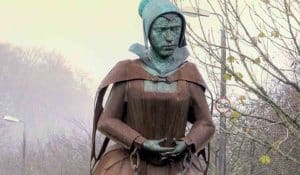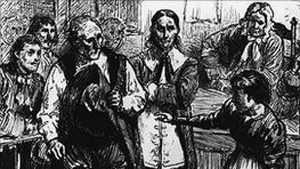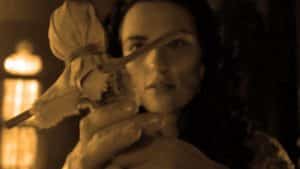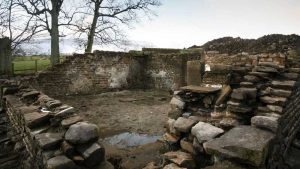Jennet Preston was the one Pendle Witch who was tried and executed alone in York for her alleged witchcraft crimes. BARRY McCANN describes how it happened.

As history records the Pendle Witches of Lancashire were tried at Lancaster Castle in August 1612, but there is one who actually met her fate at the York Assizes of July that year. Being from Gisburn-in-Craven which back then was within the Yorkshire border (though now part of Lancashire), she was assigned to York Castle to stand her trial.
Jennet Preston was a woman probably in her forties, the Gisburn Parish Church register listing the marriage of a Jennet Balderston to William Preston 25 years earlier on 10 May 1587. Later in her life, she was employed as a housekeeper by Thomas Lister of Westby Hall and by all accounts made welcome in his home. It is also thought she became his mistress.
Lister died in 1608, but his son also called Thomas continued her employment. But then in early 1612 she appeared before the Lent assizes at York accused of witchcraft and causing the death of one ‘Dodg-sonne’s child’, thought to be Thomas Dodgson listed as baptised at Bolton-by-Bowland on 10 September 10 1610, while a Thomas Dodgsonne interred on April 19th 1611 and supposed to be the same child. Jennet stood before Judge Bromley and was acquitted by the jury.
The Pendle Witches at Malkin Tower
However her fate was sealed just days later when, on 6 April, she was one of many attending a Good Friday gathering at Malkin Tower near Newchurch in Pendle, actually a small hovel and home to the Device family. A conflict with a rival family had led to Alizon Device and her grandmother known as Demdike being detained on witchcraft charges by local magistrate Roger Nowell, along with Anne “Chattox” Whittle and her daughter Anne Redfern. The four of them were hauled off to Lancaster Castle for trial at the August Assizes.
The remaining members of the family, Demdike’s daughter Elizabeth and grandson James called a secret meeting of friends, presumably to discuss the situation. Also present was Elizabeth’s nine year old daughter Jennet with what turned out to be dire consequences.
When word of the meeting reached the ears of Roger Nowell, he had all those reportedly present rounded up and questioned, resulting in many of them including Elizabeth and James being sent to Lancaster on witchcraft related charges of conspiracy and murder. They joined the three surviving others at the Assizes (Demdike having died in gaol) where Jennet Device was used as a key witness.
Jennet Preston faces her fate in York
Jennet Preston, however, was sent back to York to face her accusations alone. Having previously been acquitted, she now stood accused of murdering her previous employer and possible lover, the charge being “…shee felloniously had practised, vsed, and exercised diuerse wicked and deuillish Arts, called Witchcrafts, Inchauntments, Charmes, and Sorceries, in and vpon one Thomas Lister of Westby in Crauen”.
Witnesses claimed Lister cried out on his death bed, “Iennet Preston lyes heauie vpon me, Preston’s wife lies heauie vpon me; helpe me, helpe me,” and then died. It was also stated that when Jennet was brought in and touched his dead body it bled fresh blood, which was taken by the prosecutor as an indication she had somehow murdered him. The natural theory in their eyes was she had achieved this with sorcery. Jennet denied all charges.
Looking at the evidence today it is insubstantial and highly questionable. The fact these charges were not brought up at her previous trial during the Lent Assizes is suspicious. As she was up for murder by witchcraft, why did these supposed witnesses not come forward then and accuse her of killing Lister? Why were the charges contrived after her acquittal?
Secondly, if she was Lister’s lover then his dying words could have simply been him calling for his mistress, as opposed to his wife. Jonathan Lumby certainly posits this in his work The Lancashire Witch Craze (1995), further concluding this episode would have aroused suspicion of the affair among those present and fuelled a festering resentment of Jennet. And while she continued service in the household, Lister’s son may have seen her as an inconvenience to be rid of and his father’s good name preserved. Getting her charged and hanged for witchcraft would be perfect, as it would appear Thomas senior had been bewitched by his scheming housekeeper and therefore innocent of any infidelity.
Why was Jennet Preston charged?
So did young Lister have a hand in Jennet being initially charged and tried? If so, then that ploy did not come off, but Jennet’s involvement with the alleged witches gathering on just days later offered a second chance, statements made by James Device and Old Chattox, both naming her.
It has also been pointed out that young Lister’s recently wedded wife, Jane Heber, was the daughter of magistrate Thomas Heber who happened to be the presiding prosecutor at Jennet’s second trial. That could well be coincidence, but does have the hallmark of an inside job.
Jennet Preston protested innocence to the last as she was hanged on Wednesday, 29 July 1612 on the Knavesmire where York Racecourse now stands. It is also where Dick Turpin met his fate over a century later, but while he was a proven criminal Jennet was certainly not. As with her friends who were cruelly hanged at Lancaster, she was a victim and history should remember her as such.






